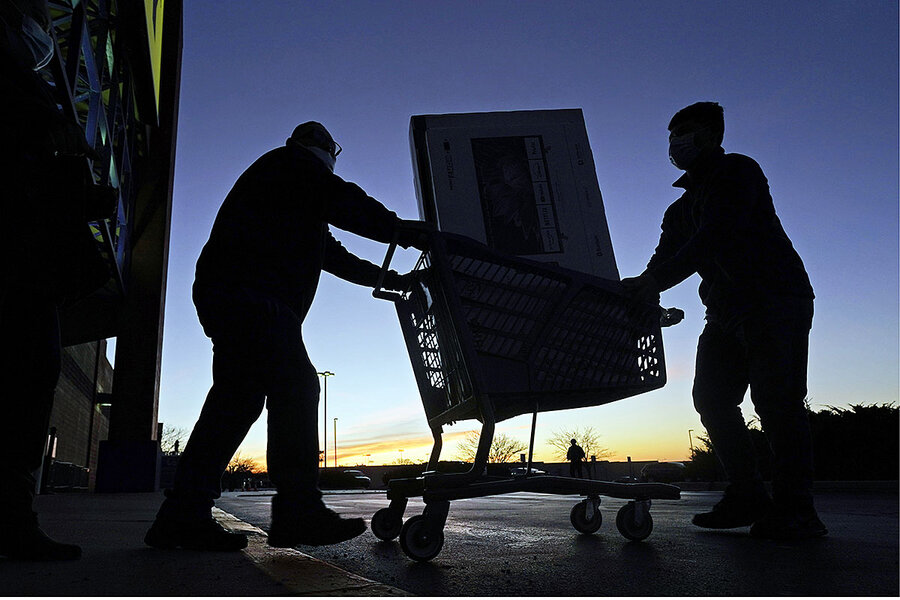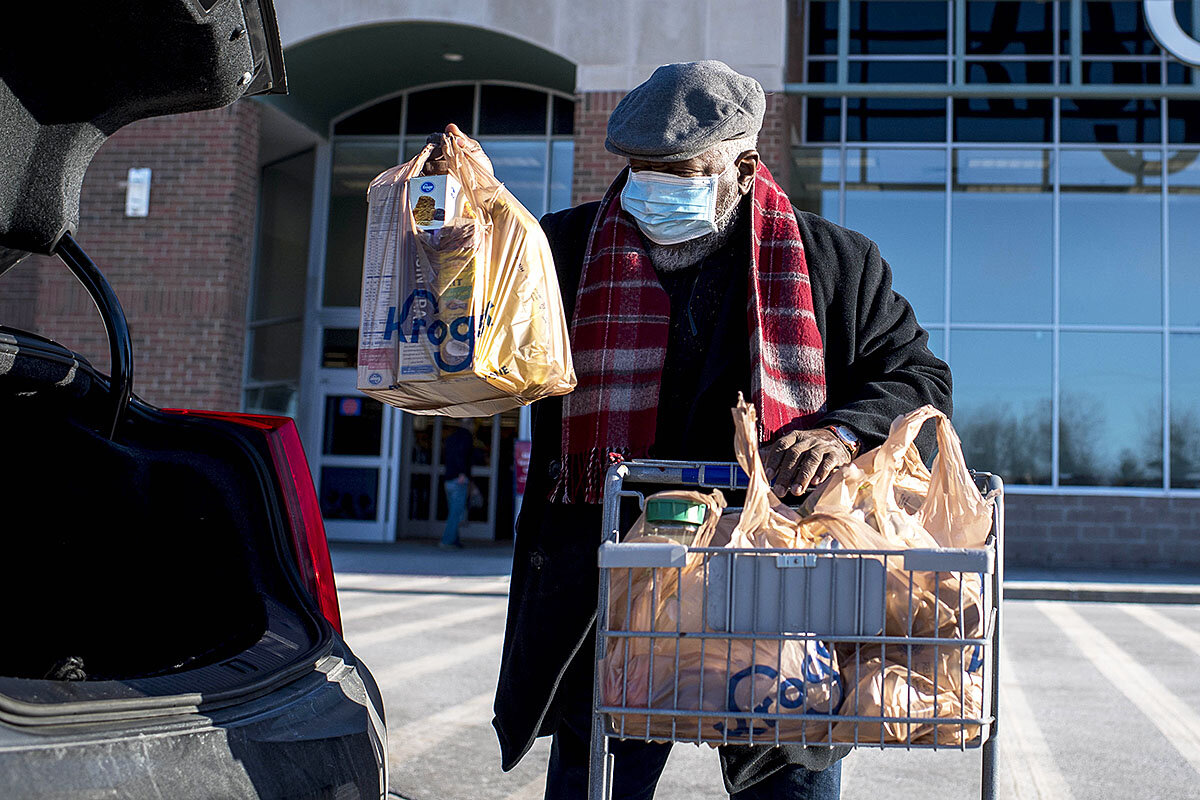What inflation looks like for two Texas families
Loading...
| New Orleans
Michelle Hallford has always enjoyed gardening. She and her husband have in part depended on their small harvest for meals since they began building their homestead in Iola, Texas, seven years ago. Now, she’s growing a larger vegetable patch to avoid the grocery store at all costs.
Ms. Hallford, a registered nurse currently on medical leave, isn’t avoiding food aisles because of pandemic caution. She’s wary of the price tags, as inflation soars nationwide.
In some sense, it’s surprising to Ms. Hallford that their working-class house of two – at times more when their daughters are visiting – feels the tremors of the nation’s latest financial shake-up. They raise cows and chickens, and they keep a lone pig fat each year for slaughter, on their 40-acre homestead. Their diet is one that’s cheaper off the vine than it is off shelves.
Why We Wrote This
Cutting back on Christmas gifts. Cultivating their own food, and even the seeds to grow it with. Americans are showing resourcefulness and sober caution as they cope with the highest inflation in nearly 40 years.
“Most of our food,” Ms. Hallford says, “comes from here at the house.”
The problem: It’s becoming more expensive to run their homestead. Feed for their livestock has increased in price by about 25% in recent months. Plus, not all prices are changing equally for everyone. So, when the Hallfords took one cow to market a few weeks back, the highest price they managed to get amounted to just 66 cents per pound – about 50% less than the $1.37 per pound they would regularly get a few years ago.
It adds up, Ms. Hallford says.
While average wages have been rising too, for many Americans expenses are adding up faster than their income can keep up. Government data this month showed the highest rate of inflation in nearly 40 years. It’s a far cry from the bland, price-level changes that Alan Greenspan oversaw while heading the Federal Reserve. As many consumers wait for some sense of stabilization, they’ve begun to wonder what the future holds – if it will be affordable or not.
“For decades, we had exactly the kind of inflation that former Chair Greenspan used to say we sought,” says Eric Leeper, a professor of economics at the University of Virginia. “But suddenly, when you see an overall inflation jump [from 1% or 2%] to 6%, and prices of things that you’re buying go up fantastically, people get unsettled.”
What remains to be seen is how long-lasting the current price spiral – and the psychology around it – will be.
For now at least the challenge is hard to brush aside. Acceleration has occurred almost every month this year, and November was the sixth consecutive month in which prices were 5% higher than the previous year, from energy (a 33% increase since 2020) to food (6%).
Why prices are “out of whack”
Mr. Greenspan famously described price stability – a policy goal for the Federal Reserve – as “that state in which expected changes in the general price level do not effectively alter business and household decisions.” In shorthand, he meant inflation so subtle that people don’t really notice the gradual price increases in their daily lives.
Now, inflation is not just rapid but also anomalous, some economists say. An unusual confluence of factors have been fueled in different ways by the pandemic: Highly expansionary fiscal policy (with $4.5 trillion in COVID-19 relief) is coupled with accommodating monetary policy. Atop that, the pandemic created supply chain disruptions across the globe – resulting in shortages and affecting some prices much more than others.
Each individual good or service has its own price. And those prices are always changing relative to each other, but the pandemic’s effect on consumer behavior and supply chains has thrown “relative prices really out of whack,” explains Dr. Leeper.
The cost of a new or used car – and also renting a car or doing automotive bodywork – has risen well above the average level of inflation in the past 12 months, for example.
“Past inflations haven’t really had these huge swings in relative prices that we’re seeing, and they haven’t been as widespread as they have been here,” Dr. Leeper says. “For example, ask yourself, what’s the price of a haircut if all the barbers are closed? I don’t know.”
The Holloway family in the Houston area felt the price spike early on. Eric and Jenna Holloway run a brand merchandise marketing company. Not only has their company experienced inventory challenges as commercial supply lines remain backed up across the globe, but their operating costs “are also going up drastically,” Ms. Holloway says. “We’ve seriously tightened our belts as far as what we’re spending” in our household, too.
The Holloways have six children – the oldest is 17 years old; the youngest, 4. That means there are eight mouths to feed in their household. Mr. Holloway does the grocery shopping.
“I see the difference,” Mr. Holloway says. “I see the price increases in the store.”
He’s seen the difference in how much their family is paying for fuel at the pump, too.
A family the size of theirs requires a large vehicle. Filling their van’s 30-gallon gas tank was one of the first price differences he noticed. Mr. Holloway says he expects to see energy prices surge next. Preparing to afford a more expensive life in general, they’re making sure this year’s Christmas season spending is leaner.
Can Federal Reserve do much?
Many American families say they’re worried about daily affordability in the near future.
Michael Sposi, an international trade researcher at Southern Methodist University in Dallas, says it’s a time for households to be careful, and watchful.
“We might have a longer spell of inflation than initially thought,” Dr. Sposi says, referring to how Fed predictions of a “transitory” bout of inflation have already gone by the wayside. “Only time will tell what’s really in store for us, as far as being worried about inflation.”
Economic predictions vary among economists, however.
“I think people are a little too worried about this,” Dr. Leeper says.
Some of the worry, he says, is natural “because young folks – not me, but others – have never seen inflation.”
Still, he notes, the Fed has a tall task ahead of it. Not only are its hands mostly tied in terms of coping with a hobbled global supply chain, but it’s also been forced to work with an incomplete data set to some extent. It’s unclear when – or if – those who left the labor force during the so-called Great Resignation earlier this year will return to the market.
“That makes it much harder to read the employment statistics to understand what’s going on,” Dr. Leeper says.
Seeds cost more too
In the meantime, what’s clear for folks like Ms. Hallford is that they have to be resourceful. But even for the most self-sufficient, resourcefulness has its limits. Ms. Hallford notices that even the price of seeds has gone up, from 99 cents a package to as high as $1.49 for the same amount.
She plans to let her crops begin to wilt and go to seed next growing season, so she can save and store the seeds to plant the following year. They’ll continue hunting and fishing, too.
“I can’t complain,” Ms. Hallford says. “I’m walking, talking, and breathing.”







